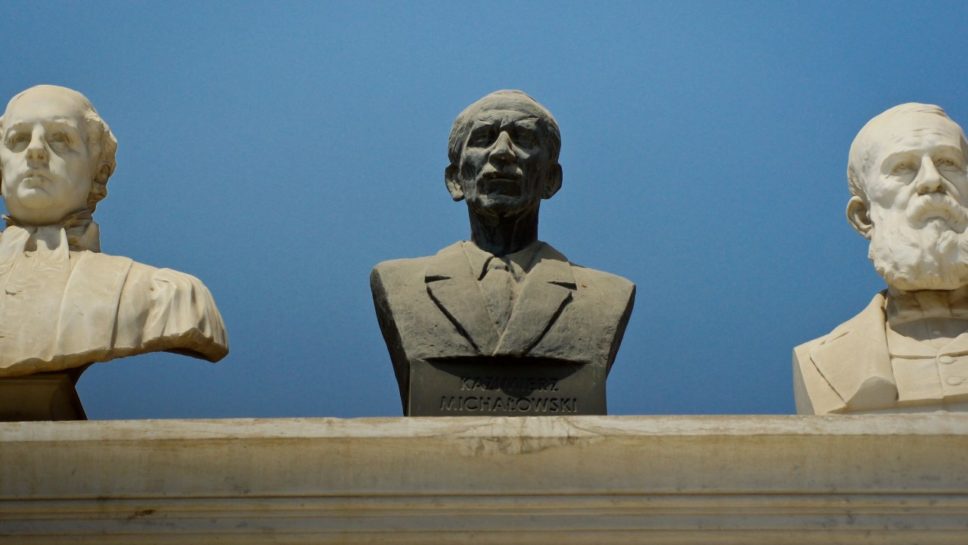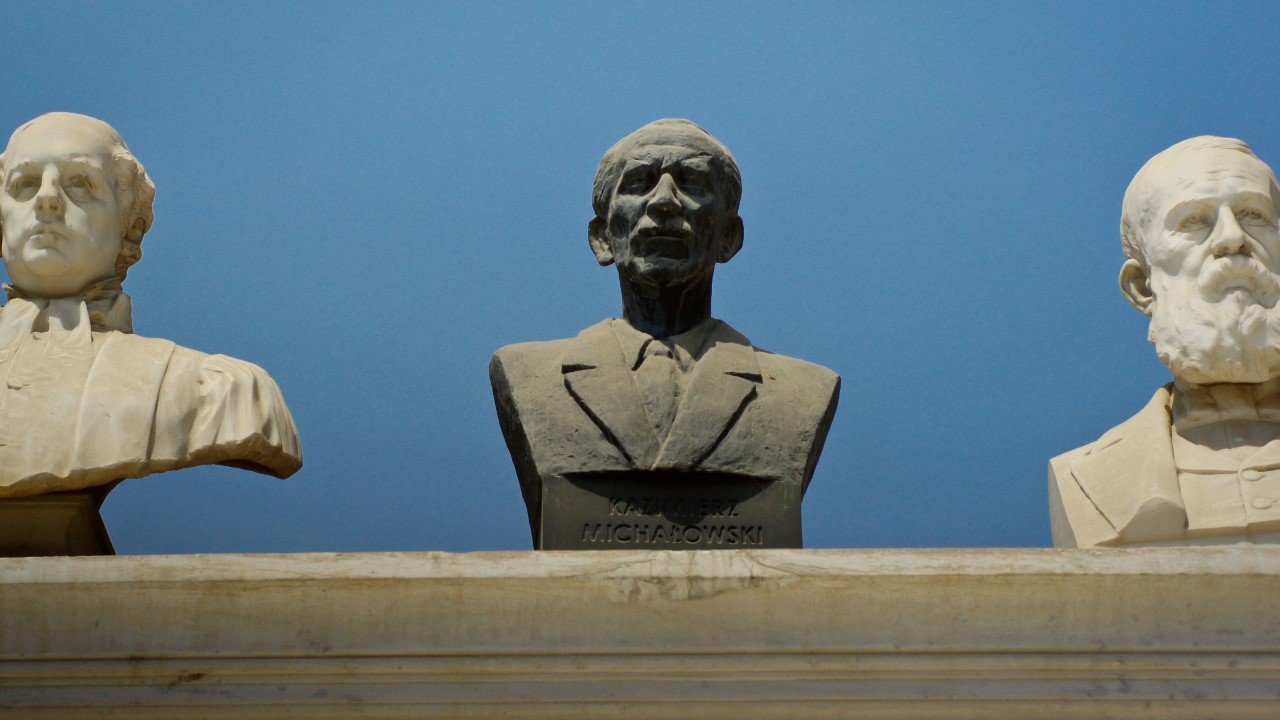Anniversary celebration in Cairo
Seventy years of Polish archaeological research in Egypt is hardly the kind of round anniversary that is ordinarily celebrated with jubilee events, but in this case it is closely connected with the commemoration of a man without whom there would be no such anniversaries to celebrate. It was Kazimierz Michałowski who headed the first Polish expedition in Egypt, who founded and was lifetime director of the Polish Centre of Mediterranean Archaeology of the University of Warsaw, and who educated and supervised generations of Polish archaeologist now active in the field.
Last year we celebrated the 105th anniversary of his birth and the 25th anniversary of his death; this year it is the 70th anniversary of the first season of digging in Egypt directed by Michałowski in Edfu and the 50th anniversary of the first excavations carried out by him after World War II in Athribis. So many anniversaries connected with Michałowski and Polish excavations in Egypt could hardly go unnoticed and in the opinion of the originators of the idea for the jubilee: Secretary General of Egypt’s Supreme Council of Antiquities Dr. Zahi Hawass, His Excellency the Ambassador of Poland in Egypt Jan Natkański and Director of the Cairo branch of the Polish Centre of Mediterranean Archaeology Dr. Zbigniew E. Szafrański, the occasion merited a worthy celebration. On behalf of the Polish Centre, I would like to thank them heartily for the idea, as well as for their generous contribution to the organization of these jubilee events.
The beginnings were modest indeed. Hampered by a lack of field experience in Egypt, Michałowski took the opportunity provided by his close association with colleagues from the Institut français d’archéologie orientale (IFAO) to excavate jointly at Edfu. In the second and third season he was already in charge of the dig. The outbreak of World War II interrupted this project, but did not stop Michałowski from planning a future of excavations in Egypt. Circumstances delayed his return to the land on the Nile by almost two decades, but in 1957, after a preparatory visit the year before, Polish excavations got off to a long awaited start in Tell Atrib. Explorations on Kom el-Dikka in Alexandria started shortly thereafter and soon after that also in Deir el-Bahari. This was the time of the great campaign for the saving of Nubian antiquities, carried out in the beginning of the 1960s under the auspices of UNESCO. Invited to participate by the Egyptian authorities, Michałowski joined in the effort with every means at his disposal. It was as if he was making up for lost time.
By 1959, beside supervising ongoing archaeological projects and opening new digs, he had also succeeded in establishing in Cairo the Polish Centre of Mediterranean Archaeology, Warsaw University’s archaeological base in Egypt. This “heroic” stage in the development of Polish archaeology in Egypt laid down strong foundations, in terms of both a young, experienced body of scholars and an institutional base, for the future of the discipline. Of the Egyptologists and Graeco-Roman archaeologists associated with Michałowski in those first years, most remained true to their interests in the study of ancient Egyptian civilization. This included the Late Dr. Barbara Ruszczyc, Dr. Tadeusz Andrzejewski, Dr. Marek Marciniak and Prof. Lech Krzyżaniak, and scholars still active today, such as Prof. Jadwiga Lipińska, Prof. Wiktor Andrzej Daszewski, Prof. Zsolt Kiss, Prof. Karol Myśliwiec and Dr. Wojciech Kołątaj.
Polish archaeological presence in Egypt grew over time, expanding from the three sites excavated in the early 1960s to more than ten today (not counting strictly epigraphic projects). A new generation of Egyptologists and archaeologists specialized in Egyptian archaeology has appeared and some of them are already in charge of PCMA missions working in the field. Every year about 50 archaeologists, not counting architects, conservators, documentalists and students, participate in the Centre’s projects in Egypt. The ranks of experts in various disciplines have been joined by epigraphists, anthropologists, pottery specialists, geomorphologists, sedimentologists and IT experts. New challenges have also been addressed, like the restoration and conservation of large architectural complexes, such as the Temple of Hatshepsut in Deir el-Bahari, and the related and increasingly important aspects of site presentation for a growing tourist industry, e.g. the monumental zone on Kom el-Dikka. Important discoveries have marked the way: the temple of Tuthmosis III in Deir el-Bahari, the tomb of Merefnebef in Saqqara, an Early Dynastic settlement on Tell el-Farkha, a complex of auditoria in Alexandria, to mention just a few.
This rapid development of its activities, including the status of the Cairo branch, the Centre owes also to the personal energy and initiative of Prof. Wiktor Andrzej Daszewski and Prof. Michał Gawlikowski, both succeeding Kazimierz Michałowski in turn as the institution’s directors. As far as the Cairo branch is concerned, the contribution of successive Secretaries who ran the office in the field cannot be underestimated. Residing in Cairo often for many years on end, they were responsible for the Centre’s position, the homely atmosphere that existed in it, and the throngs of debuting researchers whom they introduced to the realities of work in Egypt.
From the first day of digging in Edfu, a fascination with the ancient past of Egypt was coupled with a strong interest in the modern country and its inhabitants. The bonds of friendship that evolved from personal contacts and cooperation in scientific and organizational matters have always been the most important. Indeed, these relations developed often not only with scholars, but workers, raises and ghafirs, and indeed, entire communities located near the excavations. Relations with Egyptian archaeologists, museologists and conservators at all levels of Egypt’s Supreme Council for Antiquities have been invariably competent andmutually sympathetic, always expressing a readiness to providemoral or concrete support, generously good advice and, not the least, expert scientific consultation. While it would take to long to list all the Egyptian friends whom I would like to thank here on behalf of the Polish Centre and all of the colleagues making up the Polish community of scholars involved in studies of ancient Egypt?s civilization, I cannot fail to mention a number of the most outstanding Egyptian scholars: Dr. Gamal Eddin Mokhtar, Dr. Ahmed Kadry, Dr. Gaballa Ali Gaballa, Dr. Abdel Halim Nur el-Din and Dr. Zahi Hawass. We shall always be grateful for their generous attitude and never failing assistance. Without Polish-Egyptian archaeological cooperation, our achievements in this field would have been much more modest indeed.

Professor Kazimierz Michałowski’s contribution to the field of Egypotological studies in Poland and for Polish archaeology in Egypt is unquestioned. Therefore, we, who are for themost partHis students, cannot fail to appreciate Dr. Zahi Hawass and through him all our Egyptian friends and colleagues, for the idea of commemorating Our Professor with a bust placed among the images of other great Egyptologists in the gardens of the Egyptian Museum in Cairo. I have already expressed our deep gratitude to the originators of this idea, and now I would like to thank all the institutions and individuals, on the Egyptian, as well as the Polish side, who have put in much energy, time and initiative in the organization of these jubilee events. I am also deeply grateful to Michał Kazimierz Ujazdowski, Minister of Culture and National Heritage of the Republic of Poland, under whose auspices the celebrations were organized, and to Farouk Hosni, Minister of Culture of the Arab Republic of Egypt. This patronage proves that Polish-Egyptian cooperation in the field of archaeology is very deeply rooted today.
I will be forgiven the lofty metaphor when I say that Michałowski’s life’s work in Egypt is like a tree. Friendship and cooperation between Polish and Egyptian archaeologists constitute the roots of this tree, the trunk of which is the Cairo branch of the PCMA established by Michałowski. The branches of this tree aremade up of Polish scholars studying different aspects of the culture of ancient and medieval Egypt. Many years after Kazimierz Michałowski’s death, the tree that he planted can be said to have grown beautifully, its roots ever stronger and its branches ever flourishing and bearing new fruit. This tree is in our care now and it is up to us to make it grow and bloom continuously.
Text: Piotr Bieliński
Director of the Polish Centre
(introduction to: Seventy Years of Polish Archaeology in Egypt, published to commemorate the jubilee)


